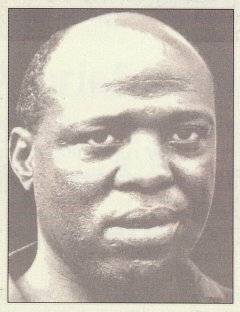

 The South African
The South African
Lt-Gen Andrew Masondo, a former general in the South African National Defence Force (SANDF) and national commissar of the African National Congress (ANC), passed away on Sunday, 20 April 2008. He played a significant role on the councils of the South African National Museum of Military History and the Northern Flagship Institution (NFl) - of which the SANMMH became a component museum in 1999 - and was associated with the Museum for eleven years.

Andrew Masondo was born on 27 October 1936 in Sophiatown, Johannesburg, the son of Alois Emmanuel Mathanjane Masondo, a Zulu from the village of Nkandla in KwaZulu-Natal, and Elsie Seraka Masondo, a Tswana from Pretoria. He was raised in a family of normal economic means who believed in the value of education. After completing his Grade 12 in 1954, Masondo went to Fort Hare University and majored in physics and mathematics. He completed his BSc in 1957 and, in the following year, became one of the first two black students to complete the BSc (Honours) degree in applied mathematics at the University of the Witwatersrand. In 1959, these two students completed the one-year University Education Diploma at Fort Hare, again the first black students to do so. By 1960, Masondo was lecturing pure and applied mathematics at the University of Fort Hare. His wide reading and cultural interaction with other scholars as well as the township community helped to develop an individual in touch with diverse groups of people.
In 1953, Andrew Masondo joined the African National Congress (ANC). In 1962/3, he held several posts within the structure of the ANC in the Eastern Cape, mainly as a rural area organiser but also in the higher command structure. In 1963, as the command director of the underground Umkhonto we Sizwe (MK) movement, the military wing of the ANC, he began to take part in sabotage activities in South Africa, cutting electricity pylons in the vicinity of Alice, armed with a number of devices, including a saw and an old rifle he had found buried in a garden. He was arrested in 1963 and sentenced to twelve years' imprisonment on Robben Island, where he was later joined by top Rivonia trialists such as Govan Mbeki, Walter Sisulu, and Nelson Mandela. In 1964, he was sentenced to an additional three years, two of which would be served concurrently with his original sentence, bringing the total to thirteen years. In prison, Masondo again turned to education. Through UNISA, he completed second-year mathematical statistics and third-year mathematics for the second time and obtained his BSc (Honours) in Mathematical Statistics. In 1975, he registered for a BCom in statistics, but did not complete the course after losing his study privileges when he intervened to defend Walter Sisulu and Govan Mbeki in a case of alleged insubordination against a white man.
Andrew Masondo was released from prison in 1976 and placed under house arrest. With the help of Oliver Tambo and his wife, he escaped to Swaziland in June 1976. From there, he went to Mozambique and Tanzania. He received military training, including a commander's course and a course in guerilla warfare, in the Soviet Union. In Angola, he became a national commissar of the MK, as well as a member of the ANC's national executive and Revolutionary Council. From 1978 to 1990, he lectured at the Solomon Mahlangu Freedom College in Tanzania, becoming the principal of the college. After serving as an MK ambassador and underground commander in Uganda, he returned to Angola in 1994, to deal with the repatriation of MK soldiers in exile, returning to a new, democratic South Africa.
The South African National Defence Force (SANDF) was established in April 1994. In the same year, Gen Masondo underwent a Joint Staff Course atthe Defence College, after which he was promoted to the rank of major-general. From 1994 until his retirement on 31 October2001 with the rank of lieutenant-general, he held many posts - Chairman of the Integration Committee, Chief Director of Equal Opportunity, Chief Director of Corporate Communication, and Chief of the Service Corps.
After his retirement, General Masondo remained active in the corporate, education, and heritage spheres of South African life. He served on numerous boards and committees in the fields of education, museums, indigenous knowledge, traditional healing, reconciliation and medicine.
Gen Masondo was appointed to the Board (Council) of Trustees of the South African National Museum of Military History in January 1997 while Director, Corporate Communications of the SANDF. When the Board of Trustees was dissolved in March 1999 and the Council of the NFl formed, Gen Masondo and Maj Gen R C Andersen, also a member of the dissolved Board, were appointed as members of the first Council of the NFl. Gen Masondo was appointed vice-chairman of this first Council of the NFl and, as the Council disintegrated, he assumed the chairmanship and remained chairman until the establishment of the second Council, thus holding the NFl together during the very difficult interim period when the new organisation desperately required leadership. While serving on the NFl Council, Gen Masondo was chairman of the Advisory Committee of the SANMMH and remained so until the dissolution of the Committee by the Council of the NFl in February 2008. As a result of his contribution to the SANMMH, the new Library and Archives complex, completed in 2005, was named after him.
Return to Journal Index OR Society's Home page
South African Military History Society / scribe@samilitaryhistory.org